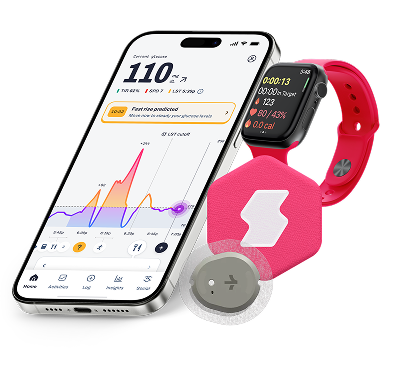Cantaloupe, also known as muskmelon or rockmelon, is a summer fruit directly related to watermelon and honeydew melon and is in the same family as cucumbers, pumpkins, squashes, and gourds.
As the most popular melon in the United States, cantaloupe can be used in fruit salads, smoothies, or topping on yogurt and ice cream. They can also be used in savory dishes like salads and salsas.
Sign up to be the first to know about special offers and exciting Signos news.
Glycemic Index Table
Cantaloupes have a medium glycemic index (GI) of 65.¹ This melon is often used as a substitute for watermelon, which has a high glycemic index rating. While the cantaloupe does have a medium glycemic index rating, the fruit is 90% water and contains little carbohydrates, allowing it to have an extremely low glycemic load of 4.

Nutritional Facts
Cantaloupes are a hydrating fruit containing 90% water and packed with vitamins and nutrients. With zero fat and cholesterol, this melon contains significant Vitamins C, A, and potassium.
The nutritional facts below are based on a 100g serving of raw cantaloupe.²
Nutritional Facts

Is Cantaloupe Good for Weight Loss?
While cantaloupes are not the first foods that come to mind when brainstorming weight loss meal ideas, this fruit can be a helpful addition to your meal plan. Cantaloupes are fat-free, low in calories, high in water, and contain fiber, which helps you feel fuller for longer. High-fiber foods can also help control appetite and reduce cravings, supporting weight loss goals.
A study was also done with premenopausal, overweight women who were asked to increase their water intake to more than 1 liter per day for 12 months. They experienced significant weight loss with reduced fat mass and waist circumference. These results were associated with water consumption.⁷ Since cantaloupe is 90% water, this hydrating fruit could help increase water intake for those looking to lose weight.
Cantaloupe is also naturally sweet, making it a healthier dessert alternative when your sweet tooth arises. Choosing cantaloupe over highly processed foods can help satisfy cravings while allowing you to stay true to your wellness goals.
Is Cantaloupe Safe for People Living with Diabetes?
People living with diabetes can certainly eat cantaloupe in moderation. Although cantaloupes have a low glycemic load, they have a medium glycemic index score. Overeating this fruit could cause a rise in blood sugar levels, so be mindful of portion size.
People living with diabetes should aim to have balanced meals that include carbohydrates, proteins, and healthy fats. By combining cantaloupe with a source of protein or healthy fats (i.e., nuts or Greek yogurt), people living with diabetes can slow down the absorption of sugar and decrease blood glucose spikes when eating this fruit.
Better health starts here.
Sign up for tips and insights that work for you!
Allergies
Cantaloupe allergies are uncommon but often found in individuals allergic to ragweed pollen.
Symptoms of an allergic reaction include itchy mouth, lips, throat, lip swelling, sneezing, nausea, and a possible anaphylactic reaction. Speak to your healthcare provider if you believe you experience an allergic reaction to cantaloupe to determine possible next steps.

References
References
- Brand-Miller, J., E. Pang, and L. Broomhead, The glycaemic index of foods containing sugars: comparison of foods with naturally-occurring v. added sugars. British Journal of Nutrition, 1995. 73(4): p. 613-23.
- USDA FoodData Central. (n.d.). Food Details - Melons, cantaloupe, raw. Retrieved from https://fdc.nal.usda.gov/fdc-app.html#/food-details/746770/nutrients
- Perez V, Chang ET. Sodium-to-potassium ratio and blood pressure, hypertension, and related factors. Adv Nutr. 2014 Nov 14;5(6):712-41. doi: 10.3945/an.114.006783. PMID: 25398734; PMCID: PMC4224208.
- Musso, G., Saba, F., Cassader, M., & Gambino, R. (2020, November 12). Diabetic Ketoacidosis With SGLT2 Inhibitors. The BMJ. Retrieved April 3, 2023, from https://www.bmj.com/content/371/bmj.m4147.short
- Harvard Health Publishing. (2019, July 18). The importance of potassium. Retrieved from https://www.health.harvard.edu/staying-healthy/the-importance-of-potassium
- Alam MA, Uddin R, Subhan N, Rahman MM, Jain P, Reza HM. Beneficial role of bitter melon supplementation in obesity and related complications in metabolic syndrome. J Lipids. 2015;2015:496169. doi: 10.1155/2015/496169. Epub 2015 Jan 12. PMID: 25650336; PMCID: PMC4306384.
- Stookey, J.D., Constant, F., Popkin, B.M. and Gardner, C.D. (2008), Drinking Water Is Associated With Weight Loss in Overweight Dieting Women Independent of Diet and Activity. Obesity, 16: 2481-2488. https://doi.org/10.1038/oby.2008.409




.svg)
.svg)
.svg)
.svg)
.svg)
.svg)
.svg)
.svg)
